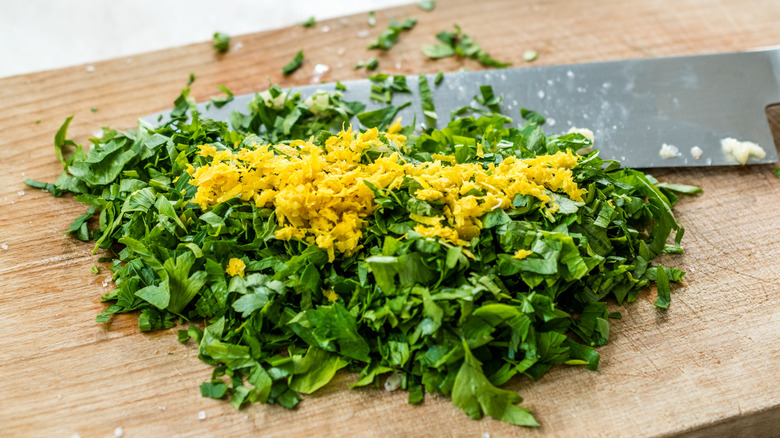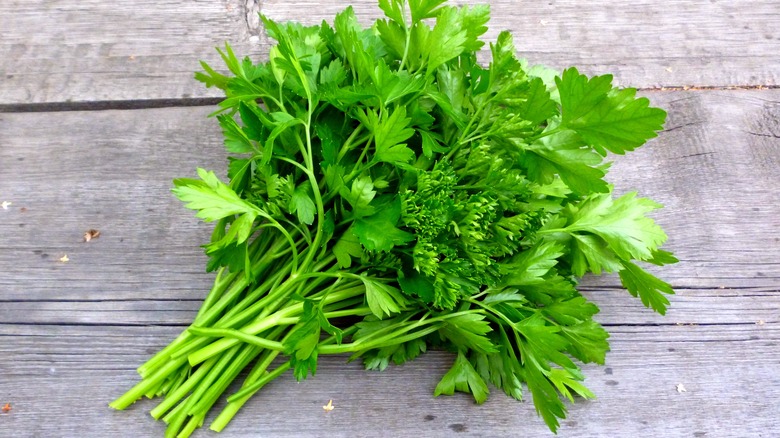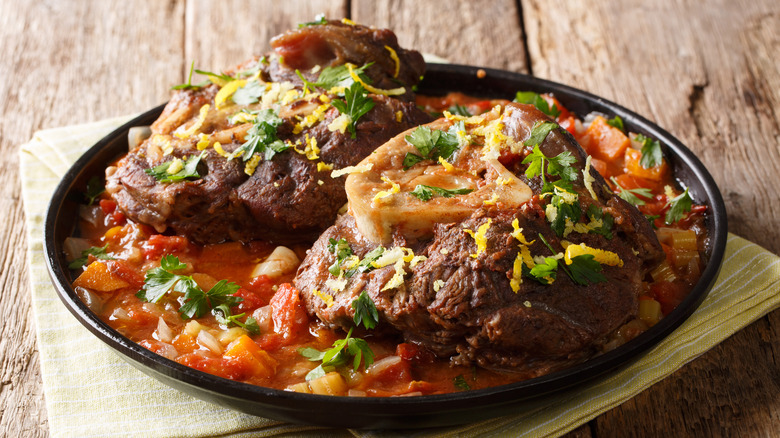The Key To Perfectly Balanced Gremolata Is All In The Parsley
One of the easiest ways to amp up a dish of roasted meat, grilled fish, or grilled veggies is to add a little gremolata. This traditional Italian condiment is a classic green sauce, sort of like pesto, but it's made with a mix of chopped lemon zest, parsley, and garlic. A little bit sprinkled on top of a rich osso buco, chicken Milanese, or roasted carrots will have your dinner guests asking, "What's the secret?"
The recipe for gremolata is extremely simple; it's really just a ratio of the three ingredients, usually around 1 cup of parsley, 2 cloves of garlic, and 2 tablespoons of lemon zest. Believe it or not, however, a lot of people make mistakes when preparing it. When it's made correctly, gremolata should add herbal freshness and complexity to a dish, cutting the heaviness of braised meats or slow-roasted game.
When it's made incorrectly, however, it ends up tasting bitter and detracting from your dish rather than adding fresh flavor. Skip taking shortcuts with things like food processors and vegetable choppers, which can bruise the delicate ingredients, and instead stick with using just a very sharp chef's knife to chop the ingredients into a fine texture. This is especially important for the parsley.
Pay attention to the parsley
The biggest component in gremolata is the parsley, so it's important to take this ingredient seriously. Parsley is often an afterthought, frequently plucked and pinched into sprigs as garnishes. But in gremolata, you build your flavor-base on its grassy, herbal profile, so be sure to choose a bunch of healthy, fresh leaves with no droopy sprigs.
Get rid of any grittiness in the parsley by washing it and then spinning it in a salad spinner to make it dry for chopping. Then, use your sharp chef's knife to chop it very finely. Parsley is what can make the gremolata bitter, so the finer the chop, the more that bitterness is spread out evenly into the mix, diluting its taste.
If you're considering tossing your bunch of parsley leaves into the food processor or blender to chop it up, stop and reconsider. When you chop the parsley for gremolata with a machine, you will overprocess the leaves, which squeezes and bruises the tender herb, releasing all its water. The result is a wet mess that will be more like a pesto, which isn't the texture you're going for; gremolata is for sprinkling, not spreading.
A sharp knife will cut the parsley into tiny, little bits, which will stay dry and mix perfectly with your lemon and garlic. Flat-leaf parsley is the best choice for this job, because it is much easier to chop by hand than curly parsley is.
How to prep the lemon and garlic
Once you have all your parsley prepped, you can chop your garlic and lemon zest. Again, like with the parsley, be sure to chop up your garlic pieces very finely, so that you can distribute them evenly alongside the parsley bits. Try using Jacques Pépin's easy method for separating garlic cloves and flattening them on your cutting board before rocking your chef's knife back and forth to make a fine dice.
For the lemon zest, make sure that you use a Microplane or bartender's zesting tool to get just the actual zest off of the fruit and none of the pith. That pith could also turn your gremolata bitter. You can chop your zest finely, as well, although some people like to leave some longer strips in the mix for a little extra color and burst of zesty flavor.
Be sure to chop all your components separately. Each element of gremolata has a different texture and will not cut the same. So, if you try to chop a pile of mixed ingredients together on your cutting board, you'll get some very small bits and some larger bits; this not only looks unprofessional, but it also leaves behind big pieces of notably bitter parsley. Take the time to properly process each ingredient, then flavor to taste with salt and pepper, and you'll always get perfectly seasoned gremolata that will make your next leg of lamb a showstopper.


